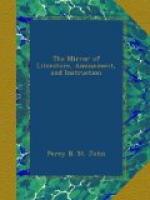* * * * *
WATLING STREET.
(To the Editor of the Mirror.)
There has been much discussion among antiquaries respecting the etymology of an ancient Roman road, called the Watling Street Way, which commencing from Dover, traces its course to London, St. Alban’s, Weedon, over Bensford Bridge,[1] High Cross, Atherstone, Wall, Wroxeter, and Chester, from which last place a branch appears to point in nearly a straight direction through St. Asaph to Segontium, or Caer Seiont, Carnarvonshire. Another branch directs its course from Wroxeter to Manchester, York, Lancaster, Kendal, and Cockermouth.
Hoveden thinks it was called the Watling Street from Wathe, or Wathla, a British king. Spelman fancies it was called Werlam Street, from its passing through Verulam. Somner derives the name from the Belgic Wentelen, volvere, versare se, a sinuosis flexibus. Baxter contends that it was made by the original Britons, Weteling, or Oedeling signifying in their language, originarius civis vel ingenuus. Stukeley’s opinion, in which he is joined by Whitaker, the Manchester historian, is, that it was the Guetheling road—Sarn Guethelin, or the road of the Irish, the G being pronounced as a W. Dr. Wilkes says, that it is more indented and crooked than other Roman Roads usually are, and supposes that it was formed of Wattles, which was the idea also of Pointer. Mr. Duff is not pleased with the opinion of Camden, that it derives its name from an unknown Vitellianus, but conjectures that its etymology is from the Saxon Wadla, a poor man, a beggar, because such people resorted to this road for the charity of travellers.
Among so many crude and discordant opinions, I shall endeavour to substitute another more consistent with the true etymology of the word. I agree with the historian of Manchester, that the Roman stations were prior to the roads, and that the latter were only the channels of communication to the former. The stations commenced during the conquest of the country, and all of them were completed at the conclusion of it. The roads therefore could not be constructed till the first or second summer after the stations were established. Whoever has attentively observed the line or direction of the Watling Street, must be convinced of the truth of the foregoing observations; and the deviation from a straight line, which in many parts is so apparent, and so evidently made to enable the Romans to pass from one station to another, may be considered conclusive upon this point. I therefore have no hesitation in asserting, that the Watling Street Way is a Roman road, and probably planned and formed by Vespasian, the celebrated Roman general in Britain, who named this road in compliment to the emperor, Vitellius, Vitellii Strata Via, Watling Street Way. Suetonius, in his Life of Vespasian,




